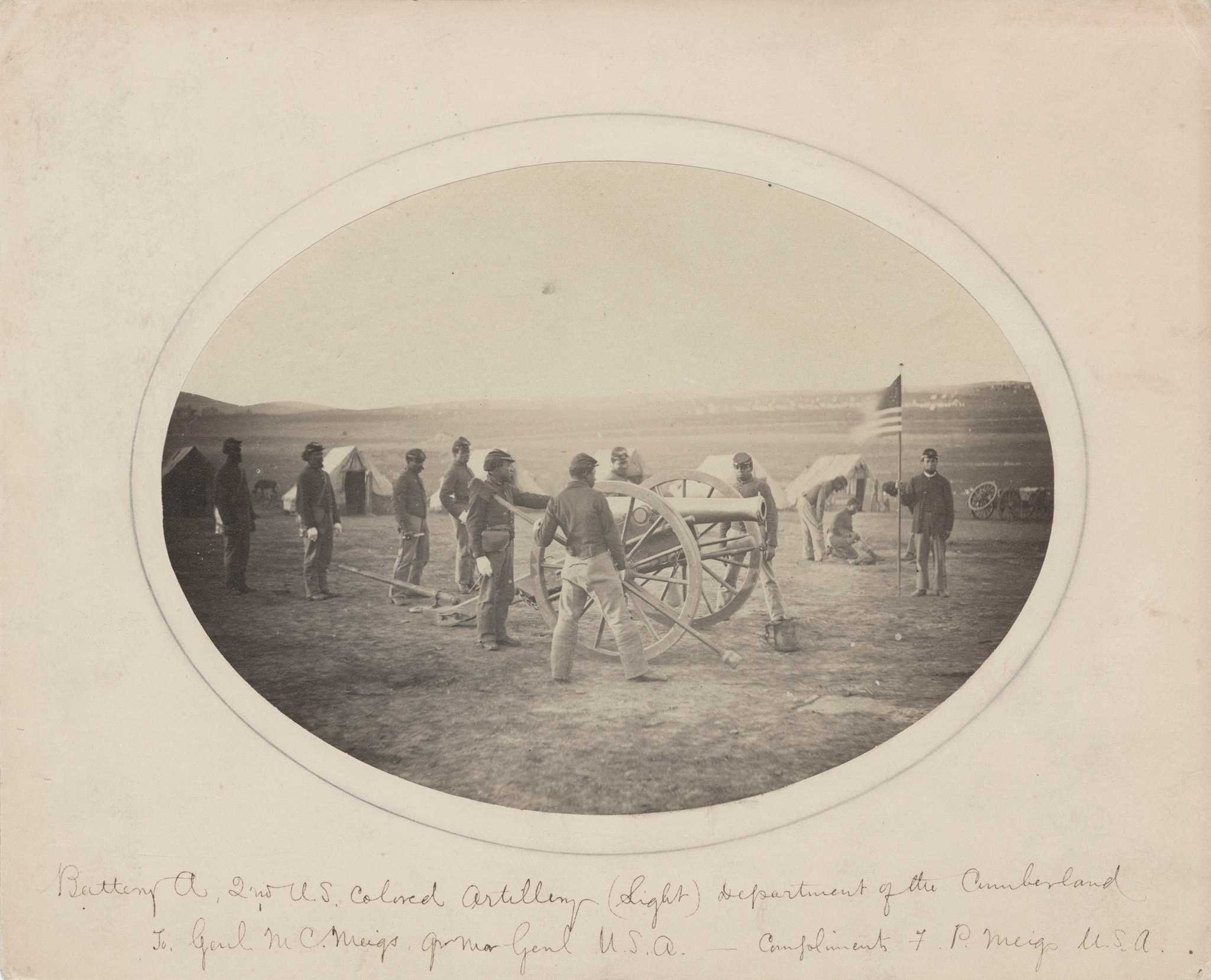Chapter 3
A Divided Nation Fights for Freedom
The election of 1860 was a turning point for the nation. The outcome would determine how the country would move forward regarding slavery. One month after the election of President Lincoln, states began to secede from the Union citing several reasons. Their demands included states' rights to maintain slavery, but also focused on property rights as they cited lack of enforcement of the 1850 Fugitive Slave Act. By April 1861, the Confederacy fired upon Fort Sumter and war was declared upon the United States. President Lincoln did not begin his term with a goal to end slavery. His military goal was to keep the Union together.
African Americans were determined to win their fight for freedom by any means necessary. They self-liberated as they escaped from plantations across the south. On January 1, 1863, the Emancipation Proclamation went into effect declaring that all persons enslaved in the rebelling states were free. It took the bloodiest war in the nation’s history to enforce the proclamation.
Like President Washington during the Revolutionary War, President Lincoln was not initially interested in African Americans serving in the military. However, based on the strategic need for increased military support and influenced by Fredrick Douglass, the president included the recruitment of Black soldiers as a provision of the Emancipation Proclamation. A war to keep the Union together became a fight for freedom and ultimately changed the nation.

Our union friends says . . . we are fighting for the union . . . very well let the white fight for what the[y] want and we negroes fight for what we want . . . Liberty must take the day and nothing Shorter.
“A colored man”, 1863
United States Colored Troops
Men of Color To Arms!
The Gun Crew of the 2nd U.S. Colored Light Artillery, 1864
When the Emancipation Proclamation went into effect in 1863, the military formed the United States Colored Troops (USCT). By the end of the war, nearly 160 USCT regiments and batteries had seen action. Even as African American soldiers fought and died, their citizenship status remained uncertain. Racist policies limited the African American officers’ corps and initially paid Black soldiers 30 percent less than their white counterparts. Soldiers protested discrimination, some risking death. These shared experiences, both on the battlefield and behind the lines, shaped a generation of African Americans.
Marquis Peterson: Freedom Fighter
Marquis Peterson
The call for “Men of Color, To Arms!” resonated with enslaved and free men of color across the nation. Marquis Peterson, a free man from Ohio, answered the appeal. However, Ohio did not receive federal approval to recruit a Black regiment until June 1863. Peterson, committed to the cause for freedom, instead joined the Massachusetts 55th Regiment that May.
A Veteran’s Story: Massachusetts 55th Regiment
Marquis Peterson mustered out of the USCT in Charleston, S.C., in August 1865. His personal effects speak to daily life during the war. In addition to a uniform and weaponry, soldiers were issued a razor and pocket Bible, which Peterson kept safe in his personal box along with letters and photographs. Other objects commemorate his service, such as a rock he collected from Fort Sumter, where the war began and where he ended his service. Peterson remained active in veteran’s organizations, including the Grand Army of the Republic, and he attended at least one of their annual national encampments. These objects, both keepsakes and standard issue, were a reminder of the crucial role he played in the fight for freedom.
Lt. John Freeman Shorter’s Diary
Lt. John Freeman Shorter’s Diary
Lt. John Freeman Shorter Diary
Lt. Shorter was one of the Army’s first African American line officers and led the fight for equal pay in the 55th Massachusetts. Shorter was a direct descendant of the Hemings family from Monticello. He left behind this personal diary that provides compelling insight into the life of a U.S. Colored Troop soldier.
Fatigue Work
Dutch Gap Canal, Virginia
African Americans in the military performed twice as much hard labor, or fatigue duty, as their white counterparts. Like many white Americans, army officers saw African Americans as being more suited to strenuous labor than white men. As trench warfare expanded, Black soldiers shouldered the burden of digging canals and building fortifications by hand, including creating the Dutch Gap Canal by the James River in Virginia. Soldiers protested but faced an unyielding military justice system. Concerned by these reports, Gen. Lorenzo Thomas investigated and began to limit some of the unfair demands placed on Black soldiers.
Dressed for Battle
The 1st South Carolina, one of the nation’s first African American infantry units, wore uniforms like this. African American freedom fighters proudly donned their uniforms and took to the battlefields to bring Black people and the nation out of the bondage of slavery.

If the world doubts our fighting give us A chance and we will show them what we can do.
Third Regiment Louisiana Volunteers Native Guard, 1863
On the Battlefield
Distinguished by their uncommon valor, African American soldiers challenged American racism. Their courage in battle, and their refusal to break ranks during fierce fighting, won them widespread national news coverage and honorary medals. African American soldiers saw battle even before the United States military accepted them into its ranks. Fighting for their states, Black regiments in Louisiana, Kansas, and South Carolina challenged the United States to change its policy and admit Black men. By the war’s end, all 160 USCT regiments had seen combat.
Each of these objects belonged to a Union soldier during the Civil War. William H. Clay, 28th USCT, owned the shield-shaped badge. Washington Perkins, 54th Massachusetts, wore the badge honoring Ft. Wagner. The U.S. belt buckle was found at Point of Pines plantation on Edisto Island in South Carolina, where the Union army set up a base camp site.
Mortality
Savage Station, 1862
One in five soldiers died during the Civil War. Many died on the battlefield, but most perished due to disease. Field hospitals were also dirty and overcrowded, leaving soldiers exposed to infection and disease. The highest death rate was among African American soldiers. Reflecting the prejudices of the times, many military commanders expected more Black soldiers to die than whites. Black soldiers and their abolitionist allies in the military called for reform, but the army was slow to respond. Investigations revealed that Black soldiers were worked twice as hard as white soldiers and received limited medical care.
Creed Miller
Creed Miller
In July 1864 Miller enlisted with the 107th USCT in Lebanon, Kentucky. Like many formerly enslaved people, enlistment marked the moment his name first entered the historical record. Miller commemorated the moment with a tintype photograph and an identification badge.
Butler Medal
Butler Medal, 1864
Officially known as Army of the James Medal, Gen. Benjamin F. Butler commissioned this military decoration to recognize feats of bravery by African American soldiers. These are the only U.S. medals designed specifically for African American troops.
Sgt. William Carney, 54th Massachusetts Infantry, ca. 1863
Sgt. William Carney
On July 18, 1863, the 54th Massachusetts U.S. Colored Infantry began its assault on Ft. Wagner. Charging uphill into battle, the unit suffered terrible losses. When a color bearer fell, United States Colored Troop member Sgt. William Carney caught the Union flag and never let it touch the ground. He was subsequently awarded the Medal of Honor for his actions at Ft. Wagner.
